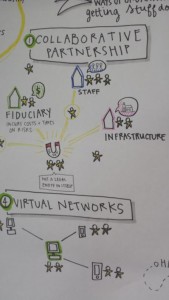The successful SPARC – Symposium for Performing Arts in Rural Communities held in Haliburton, Ontario in April 2014 led to the desire to establish a network of people and organizations to strengthen performing arts in rural communities. The resulting SPARC Network Summit was held in November 2014.
To meet the Steering Committee’s ambitious goals its members focused on creating the conditions in which all participants could explore, discover and define the next action steps in creating a new kind of network.
1. The co-facilitators
SPARC engaged two expert facilitators:
- Myself, because I know the performing arts nationally, I spoke at the first SPARC Symposium and am well-versed in design and delivery of complex facilitation requirements.
- Jim Blake, an experienced facilitator, artist and community development consultant who has been involved in SPARC since its inception as a member of its Steering Committee.
2. Pre-summit package
We developed a pre-summit package for participants that provided a short history of SPARC and its proposed vision. I contributed a concise historic overview of performing arts in Canada; an overview of existing networks in the performing arts, their typical services and activities ;and information about four major organizational models and online platforms. SPARC shared results from two surveys related to forming a rural network and its potential activities. To help participants prepare, we shared key questions for the Summit. (Download the package here: PRESUMMIT PACKAGE_Oct28)
3. Active recruitment of participants
Recruitment communications made clear that participants would be prepared to think about all the facets of creating a network, from the big picture needs to operational priorities. Happily, most of the about 25 Summit participants had attended the Symposium and carried over the great energy from that content-rich 4-day conversation into this Network Summit.
4. Designing the Summit
Jim and I designed these two and a half days of conversations using a design thinking approach that opened opportunities for exploration and creativity, analysis and synthesis, convergent and divergent thinking. There was no pre-defined destination, no right answers, but rather a general goal – strengthening the performing arts in rural communities – and deliberative processes that ensured all participants had a voice and used it.
Friday evening was devoted to rekindling connections from the April Symposium and introducing those who were new to SPARC through conversation and sharing food.
Saturday was devoted to exploration: The facilitators led participants through a series of working sessions designed to explore important questions about issues participants faced that held them back in realizing their visions in their work, what kinds of gaps currently existed, what SPARC as a network might do in response, how it might operate, who it would be for, how the network could be activated as a valued resource, what participants could contribute to a rural network and what they needed from it.
Through a series of structured and unstructured work in pairs and small groups participants explored, discussed and debated these questions and arrived at identifying existing gaps and key opportunities for SPARC moving forward.
This was followed by dinner conversations and sleep. Well, some also had a great time at a Harry Manx concert.
Sunday was devoted to decision-making and next steps: The co-facilitators presented outcomes from Saturday’s exploratory work for validation and feedback. Through plenary conversation and another round of small group discussion, participants came to agreement on several key decisions to move the SPARC network forward.
5. Outcomes
- adopt a focused range of activities that fill existing gaps in a rural context and is centred on a well-curated online information portal and interactive tools to connect people
- convene three working groups: 1. Online Communications; 2. Outreach and Partnerships; 3. next SPARC Symposium
Organizationally, the consensus was to:
- keep SPARC agile, open and responsive by keeping its current structure as a collaborative partnership and build out its foundations through expanding partnerships. As a collaborative SPARC does not exist as a separate legal entity, but rather uses its partners to provide the requisite financial management, office space and infrastructure, knowledge and people.
- keep the Network’s focus on Ontario, while sharing developments with other rural regions/networks with the intention that SPARC could become a model for a national rural network to connect hubs across Canada.
Current implementation activities include:
- finalizing terms of reference for the working groups
- presenting a session at the Canadian Arts Presenting Association’s (CAPACOA) national conference in Halifax in January 2015.
- publishing an interactive report of outcomes using the various modes of recording the proceedings (video, a graphic recorder, many flip charts and worksheets) in early 2015.
- investigating funding for a series of regional working sessions/consultations across rural Ontario in 2015-2016.


